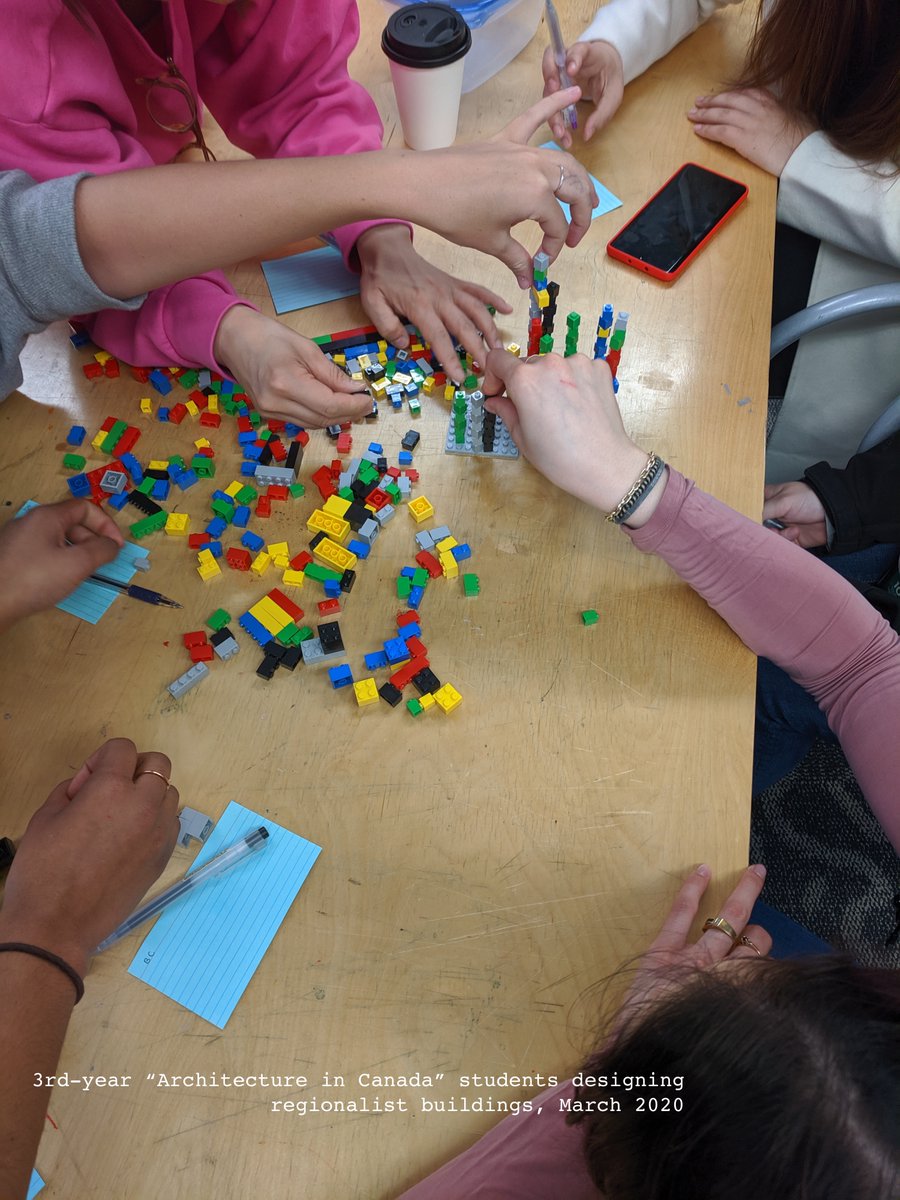
I’m a big fan of “small teaching” to promote connection, self-explanation and practice in the classroom (Lang 2016).
Collaborative Lego, drawing, or design challenges break routine, build concepts, and let students think through problems in unexpected ways.
#OAHdebrief2020 3/

Collaborative Lego, drawing, or design challenges break routine, build concepts, and let students think through problems in unexpected ways.
#OAHdebrief2020 3/


Kids learn from play, adults can too!
With big intro courses (90-300 students❗️) the most equitable/accessible outlet for these activities is the discussion board.
So, how to translate this online? How can they engage meaningfully with the content + have fun?#OAHdebrief2020 4/
With big intro courses (90-300 students❗️) the most equitable/accessible outlet for these activities is the discussion board.
So, how to translate this online? How can they engage meaningfully with the content + have fun?#OAHdebrief2020 4/
The formula's simple: set an activity based on your content that gets them to move, make, or play. Then, have them reflect on the process, dissect it/link it to course concepts + discuss with their classmates.
Lots of ways to get creative with this! #OAHdebrief2020 5/
Lots of ways to get creative with this! #OAHdebrief2020 5/
Want some ideas? Here's an example I ran in my intro survey— let's try it together!
But first, some mood music (yes, I really post corny music videos in my prompts... instructor presence ✅)...
#OAHdebrief2020 6/
But first, some mood music (yes, I really post corny music videos in my prompts... instructor presence ✅)...
#OAHdebrief2020 6/
Strike a pose! 💃
Replicate the pose of 2/3 of the images below. Students were asked to post photos, but you don't have to! If unable for any reason (anxiety/mobility) students just described in detail.
Describe your experience of posing. What did you notice?
#OAHdebrief2020 7/


Replicate the pose of 2/3 of the images below. Students were asked to post photos, but you don't have to! If unable for any reason (anxiety/mobility) students just described in detail.
Describe your experience of posing. What did you notice?
#OAHdebrief2020 7/



(cont.) Discuss the similarities and differences between your chosen poses. Based on all of this, what observations can you make about the materials, eras or cultures?
This gets students moving, reflecting/connecting dots, and sneakily doing a compare/contrast!
#OAHdebrief2020 8/
This gets students moving, reflecting/connecting dots, and sneakily doing a compare/contrast!
#OAHdebrief2020 8/
So we’re doing some conceptual scaffolding by sneaking in a classic art-history tool (also used in a later, higher-stakes assignment 👍) but also community building…
Students felt connected to their classmates, and keen to see what everyone had done.
#OAHdebrief2020 9/
Students felt connected to their classmates, and keen to see what everyone had done.
#OAHdebrief2020 9/
This makes the classroom feel more personal. Seeing that there are real people behind the avatars helps students connect (Darby 2019).
⬆️ social presence = ⬆️ cognitive presence (Garrison et al. 1999).
#MethodToMyMadness #OAHdebrief2020 10/
⬆️ social presence = ⬆️ cognitive presence (Garrison et al. 1999).
#MethodToMyMadness #OAHdebrief2020 10/
Fun, right? Here’s another I call "Building on what we’ve learned:"
Pick a monument (building, large-scale sculpture) from class/textbook + recreate it using materials from around the house, backyard, porch, anything at your disposal! #OAHdebrief2020 11/
Pick a monument (building, large-scale sculpture) from class/textbook + recreate it using materials from around the house, backyard, porch, anything at your disposal! #OAHdebrief2020 11/
Students then shared/reflected on the process + linked to what they knew about the object.
They noted it made them look closely, think about the construction, want to learn more, and were eager to see all of the creations! Guess what the examples are below... #OAHdebrief2020 12/

They noted it made them look closely, think about the construction, want to learn more, and were eager to see all of the creations! Guess what the examples are below... #OAHdebrief2020 12/


Note: setting a time limit is a good idea, especially if studio students are in the mix... I said no more than 20 mins for this exercise.
In any case, these kinds of activities engage a variety of learners and learning styles—huzzah!
#OAHdebrief2020 13/
In any case, these kinds of activities engage a variety of learners and learning styles—huzzah!
#OAHdebrief2020 13/
Want more? What about Pictionary? Pick a work from XYZ chapters in the text + describe. See if classmates can guess.
...Gets them familiar with the text, practices terminology, builds toward visual analysis, promotes team-building, and is a fun game!
#OAHdebrief2020 14/
...Gets them familiar with the text, practices terminology, builds toward visual analysis, promotes team-building, and is a fun game!
#OAHdebrief2020 14/
Send them outside! (Some of you noted this in your own tips!)
For my Canadian architecture classes next term, for ex., students will pick a local building and visit it 3 separate times to track changing observations as the course progresses. #OAHdebrief2020 /15
For my Canadian architecture classes next term, for ex., students will pick a local building and visit it 3 separate times to track changing observations as the course progresses. #OAHdebrief2020 /15
And quick plug while on the topic of Canadian architecture... check out our new project @canconstructed: boosting course offerings @ArtHistory_uoft, creating internships and interest more broadly! Teaching-focused events coming soon!
💻 canadaconstructed.ca #OAHdebrief2020 /16
💻 canadaconstructed.ca #OAHdebrief2020 /16
Overall, don't be afraid to shake up your prompts and get a little creative! Get a little weird, even, and share your love of art history with your students! I think you'll be surprised by the results with a few simple changes 😄
Thanks for following along!
#OAHdebrief2020 17/17
Thanks for following along!
#OAHdebrief2020 17/17
I'll stick around for a bit on this account if anyone has questions or wants to chat!
Otherwise, you can find me @doctormace 🤓
#OAHdebrief2020
Otherwise, you can find me @doctormace 🤓
#OAHdebrief2020
• • •
Missing some Tweet in this thread? You can try to
force a refresh


